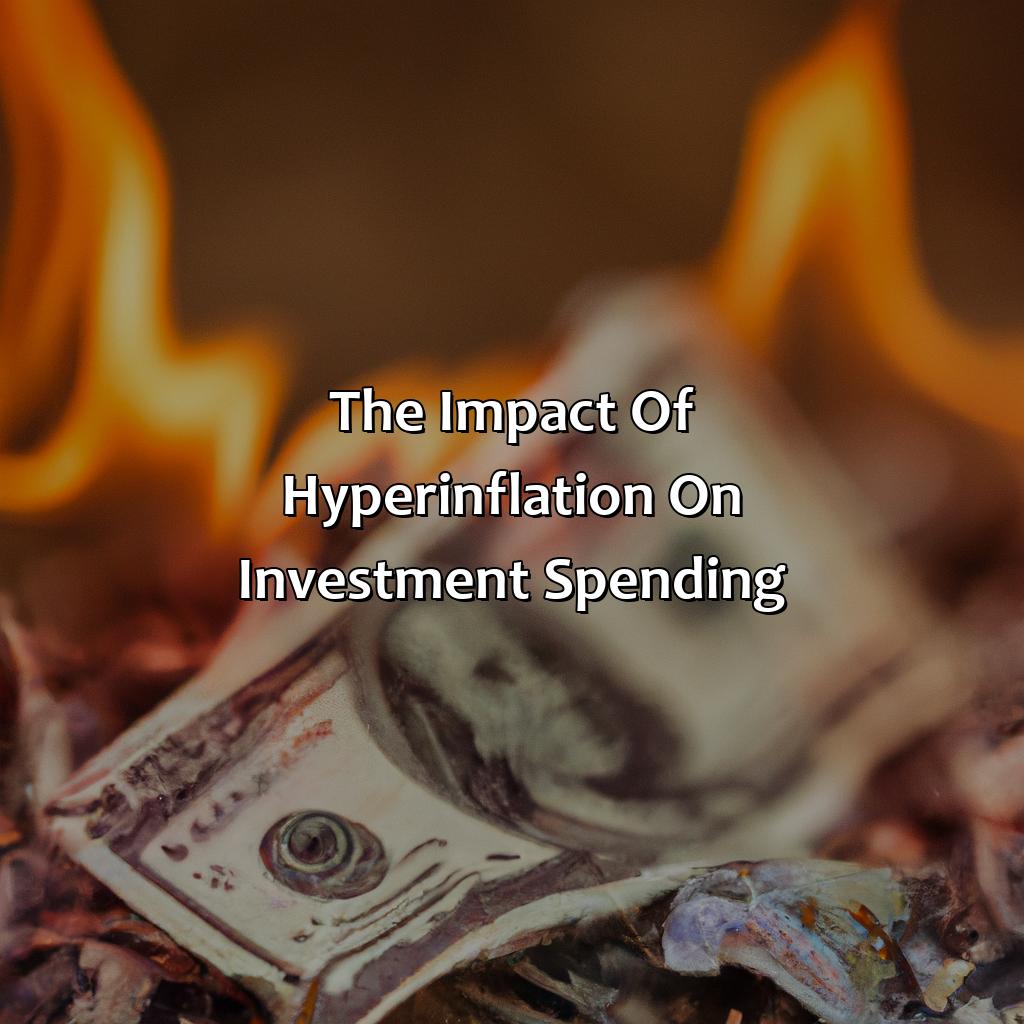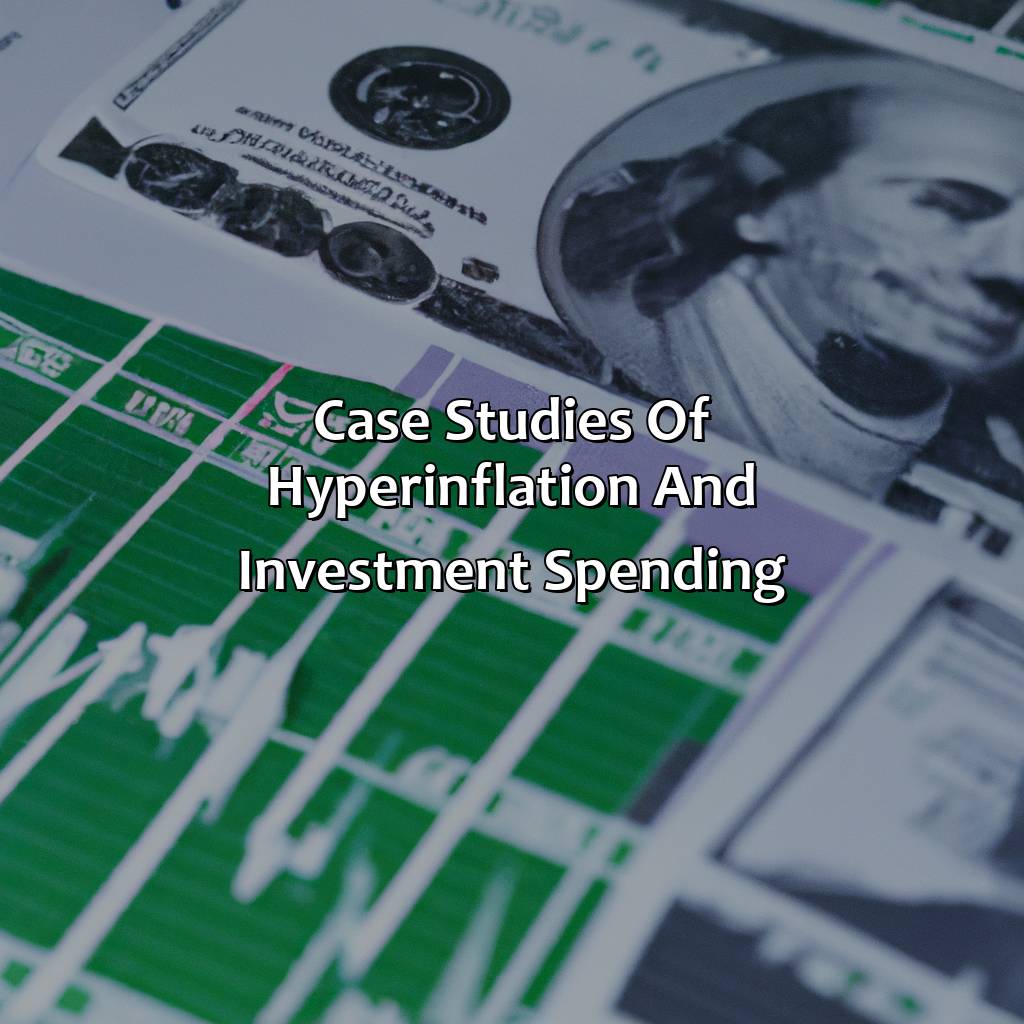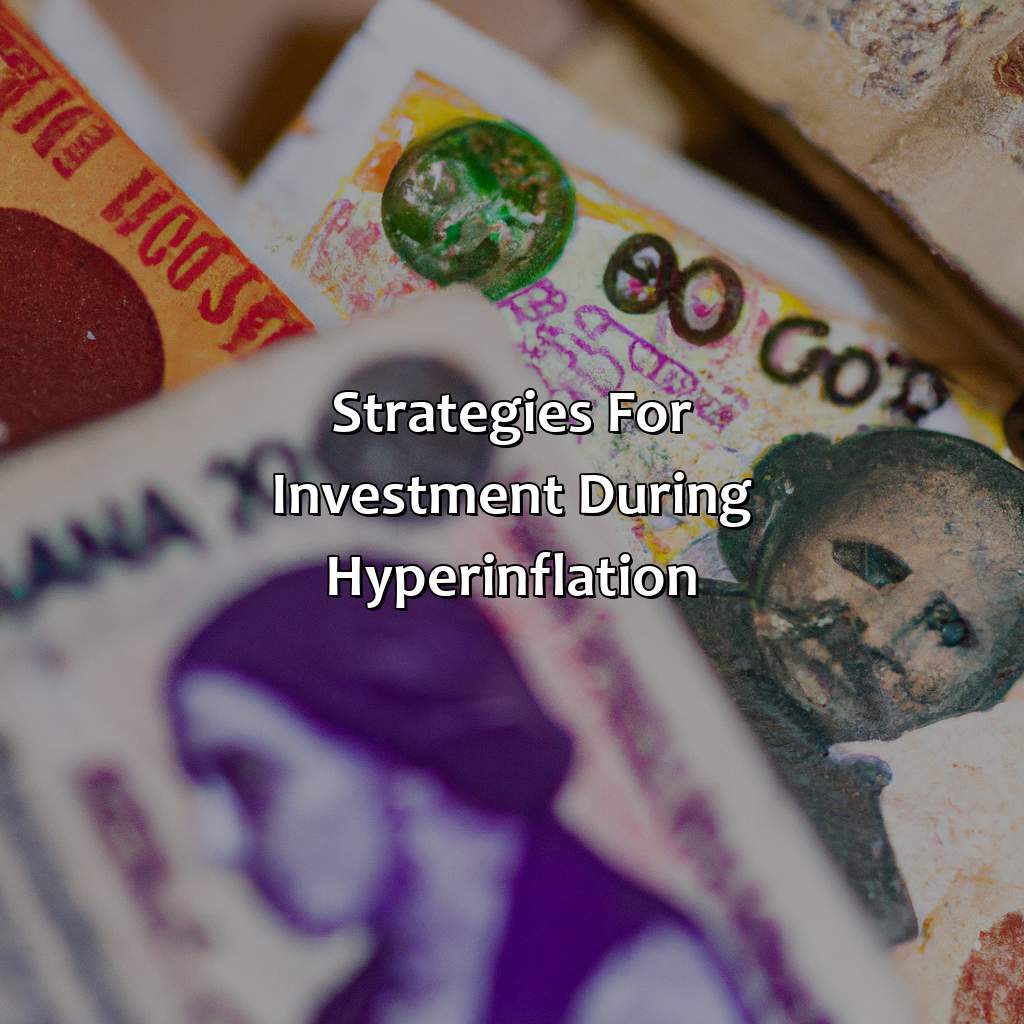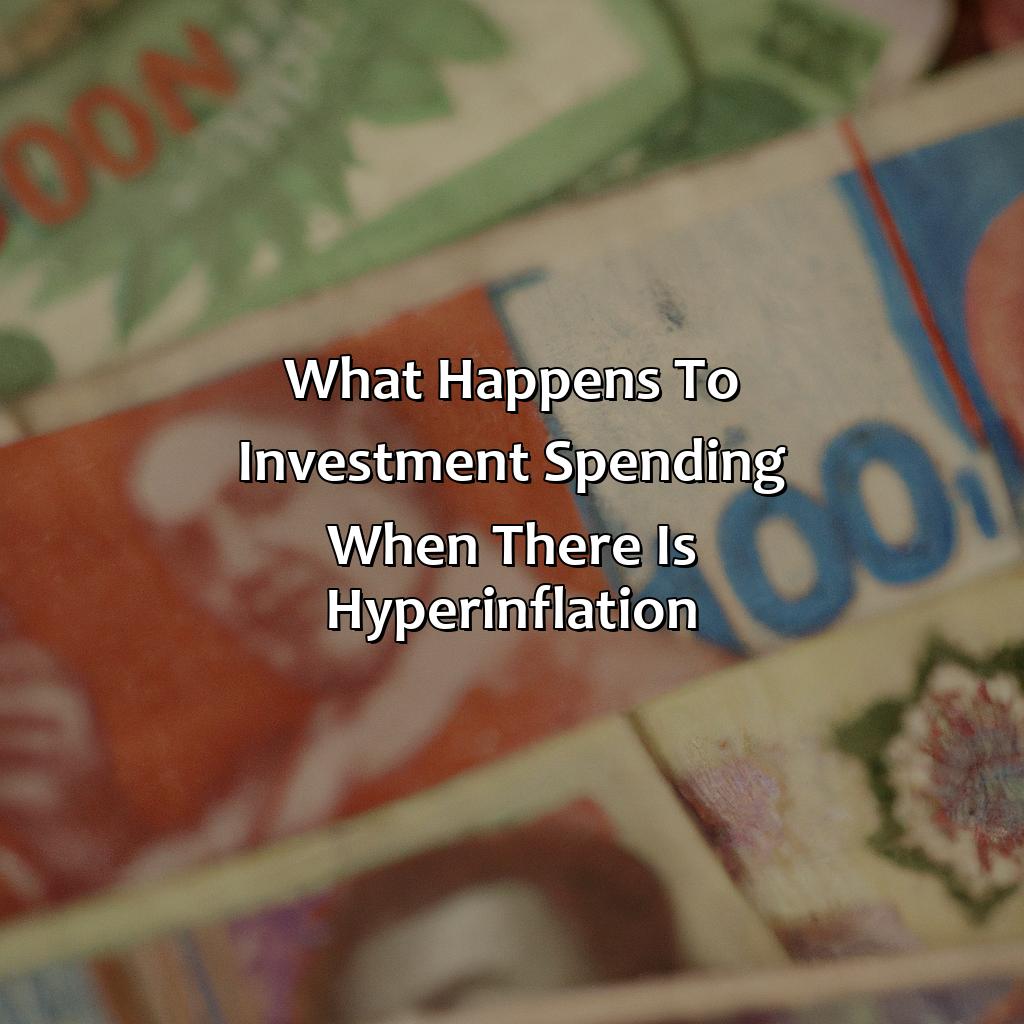What Happens To Investment Spending When There Is Hyperinflation?
Key Takeaway:
- Hyperinflation impacts investment spending negatively by causing uncertainty, leading to reduction in long-term investments, but also leading to an increase in short-term investing as investors focus on immediate gains.
- During hyperinflation, there is a shift towards physical assets and stable currencies such as gold and foreign currencies.
- Strategies for investment during hyperinflation include diversification, investing in stable currencies, and short-term investing, with a focus on monitoring inflation rates.
Are you worried about your investments when the economy is going through hyperinflation? In this article, we will discuss the impacts of hyperinflation on investment spending. You will learn how to plan your investments to protect your wealth in a time of hyperinflation.
The impact of hyperinflation on investment spending
To get a better comprehension of hyperinflation’s effect on investing, with its subsections:
- Uncertainty reducing investment
- Short-term investment increasing
- Switching to physical assets and currencies

Image credits: retiregenz.com by David Jones
Reduction in investment due to uncertainty
Investment spending follows a downward trend during periods of hyperinflation. The lack of stability leads to uncertainty, which makes investors hesitant to park their money in the market. Economic agents cannot predict future prices and business prospects, resulting in a reduced investment appetite. This scenario impedes new investments in both domestic and foreign sectors.
Strong uncertainties surrounding political decisions and macroeconomic policies contribute to this negative impact. The cost of goods and services increase at a rapid rate, while wage levels can’t keep up with the rise in prices; thus, reducing consumer spending capacity. Moreover, sellers raise prices even further due to increased demand for their goods caused by rising inflation rates.
The adverse effects of hyperinflation impede investment development projects on the whole that will last long enough to recover from financial crises or unpredictable events when economic variables fluctuate wildly. This uncertainty leads to higher risk-related costs that businesses are forced to assume, making investments an even rarer possibility.
To mitigate this challenge, analysts suggest keeping interest rates stable during inflationary periods, which could help provide investors with forecasts of expected capital gains and hence facilitate earlier planning concerning buying opportunities. Additionally, governments could implement measures such as production subsidies or tax breaks for sectors that create jobs; promote international trade agreements that support exports from those sectors; regulate fiscal policies to avoid excessive public debt levels which could reduce investor confidence – these would help stabilize markets leading to more secure investment environments overall.
Looks like investors are ditching long-term commitments for short-term flings with stocks during hyperinflation- it’s like speed dating for investments.
Increase in short-term investing
Investors tend to resort to quick-term investments during hyperinflation. This is because high inflation poses a risk of devaluing long-term investments, leading investors to pursue short-term gain and liquidity.
They might invest in commodities that are quickly marketable, such as precious metals or foreign currencies, as well as real estate purchases that can be turned around rapidly for profit. This significant increase in short-term investing is an attempt to mitigate the risks posed by hyperinflation and avoid long-term impacts.
However, short-term gains may come at the cost of long-term stability. Investing only in short-term solutions may not lead to sustainable growth or lasting profit margins.
It’s worth noting that during the hyperinflation experienced in Zimbabwe between 2008 and 2009, vending became a popular form of investment for many individuals who could not afford traditional investment options.
In times of hyperinflation, investing in physical assets and currencies is like hoarding toilet paper during a pandemic.
Shift to physical assets and currencies
Investors tend to switch their focus from paper assets to physical assets and currencies during hyperinflation. This is due to the fact that paper assets, such as stocks and bonds, lose their value rapidly in an inflationary period. Physical assets like real estate, precious metals, and commodities are considered a safer option as they act as a hedge against inflation. Currencies of stable countries also become popular among investors during hyperinflation as they hold their value better than local currencies.
Investing in physical assets requires specialized knowledge and experience.
During hyperinflation, people tend to invest in physical assets instead of paper assets due to their intrinsic value. Precious metals like gold and silver are used as a store of wealth for centuries and appreciated over time. Real estate is also considered more reliable because it tends to appreciate despite the presence of inflation or deflation. Commodities like oil, food items, etc., can be held for future sales at higher prices.
In the past, when Zimbabwe experienced hyperinflation after printing large amounts of money which led to 80 billion percent year-on-year price increases, locals started buying goods that hold long-term value such as cattle or imported household goods that could retain their value even if government currency failed completely. The demand for tangible assets increased rapidly during this period.
In summary, shift towards holding physical assets and currencies rather than paper money or any other valued-assets is seen an effective way to protect oneself from rampant inflation in the economy.
Hyperinflation turns investors into survivalists – forget stocks, go invest in canned food and ammunition.
Case studies of hyperinflation and investment spending
Investment during hyperinflation? Examine case studies! Look at Zimbabwe, Venezuela, and Germany. Discover how nations have handled investment in times of economic instability. Unearth how historical examples can forecast behavior and grasp the effects of hyperinflation on investment choices.

Image credits: retiregenz.com by Joel Woodhock
Zimbabwe
The African nation with severe hyperinflation has faced a significant economic crisis that has affected investment spending. Zimbabwe’s economy has experienced one of the world’s worst hyperinflations, leading to a sharp rise in prices and a decline in its currency value. As a result, investors lost confidence in the country’s financial system, causing investment spending to drop dramatically.
At the peak of its economic crisis, Zimbabwe’s inflation reached 79.6 billion percent in November 2008, making it difficult for businesses to operate and invest. Consequently, most companies reduced their investments and purchasing power due to high inflation rates.
In recent years, Zimbabwe’s economy has improved due to various reforms by the government. The country now offers several potential investment opportunities such as agriculture and mining sectors. Companies like Old Mutual Limited have started investing money back again into Zimbabwe after almost two decades of political unrest.
According to Bloomberg Markets, “Zimbabwe’s first foreign exchange auction since September disposed of $12m at an average rate more than double the official pegged price” on January 19th, 2021.
In summary, this case study shows how hyperinflation can have a detrimental impact on investment spending for any nation experiencing it. Although rebuilding investor confidence can take years, implementing reforms can help bring about positive changes for countries facing such crises.
I guess you could say Venezuela’s investment spending got hyperinflated, but their economy didn’t exactly soar.
Venezuela
During Venezuela’s period of economic crisis and hyperinflation, there was a significant decline in investment spending as investors struggled with exchange restrictions and high inflation rates. This made it challenging for businesses to obtain the necessary funding for investments. Additionally, government-induced price controls led to shortages and inefficient allocations of resources.
Moreover, Venezuela’s political instability worsened the situation by scaring off investors. This created an unfavorable investment climate that further hampered investment spending.
Pro Tip: During periods of hyperinflation, it is crucial to diversify investments across multiple foreign currencies and assets to reduce overall risk exposure.
Investing during hyperinflation is like betting on a horse with a broken leg- the odds aren’t in your favor.
Germany
During the hyperinflation period in Germany, investment spending took a drastic turn due to the unstable economic environment. Businesses faced challenges with raising funds for investments, and citizens lost trust in the local currency. As a result, they preferred to hold foreign currencies or convert their savings into tangible assets. Investments in infrastructure, real estate, and businesses were impacted severely. The government also resorted to funding their expenses by printing more money leading to further inflation. The situation ended only after the introduction of a new currency that stabilized the economy.
It is noteworthy that during hyperinflation, businesses and individuals tend to avoid investing long-term due to the uncertainty surrounding future prices. They prefer holding cash instead of making investments which can result in severe consequences both economically and socially.
Historical events show us how hyperinflation can cause havoc leading to significant changes in markets, individual behaviours and even political systems. Venezuela is an example of this phenomenon where hyperinflation has led to some of the world’s worst deficiencies coupled with corruption and misgovernance.
In Zimbabwe, farmers saw little incentive as their crops lost value rapidly; inflation became so extreme that workers were paid more frequently out of fear that pay earned one day will be worthless in subsequent days or weeks. Consequently, industries closed down resulting in massive unemployment levels.
The tenuous nature of hyperinflation means that both individuals and businesses must adapt quickly to avoid being negatively affected by its effects. Investing during hyperinflation is like trying to outrun a cheetah in flip-flops – it’s possible, but not recommended.
Strategies for investment during hyperinflation
Navigating hyperinflation’s challenges? Strategies can help your investment grow. Diversify, invest in stable currencies, and go for short-term investments. These tactics will help mitigate hyperinflation’s impacts and protect your investments.

Image credits: retiregenz.com by David Duncun
Diversification
Expanding one’s portfolio to include various asset classes is crucial in mitigating risks caused by hyperinflation. This risk-management technique, known as portfolio diversification, involves investing in different assets that have a low correlation with each other. By doing so, any losses incurred from one asset or market are offset by gains from another. Diversified portfolios tend to yield higher long-term returns and reduce the effects of inflation on investments.
In hyperinflation scenarios, investors usually lose trust in their currency and prefer to invest in more stable assets such as gold, real estate, and foreign currencies. These assets help protect their wealth from losing value due to rising inflation rates. Investors can also consider alternative investments such as private equity or hedge funds to gain exposure to non-traditional or complex markets.
Furthermore, diversification should not only be limited to asset classes but also geographical locations and sectors. As global events impact different regions differently, it is critical for investors to hold international investments that offer protection against domestic unrest or economic decline. Investing across multiple sectors ensures that one’s portfolio is not solely reliant on a particular industry’s performance.
Pro Tip: While diversifying a portfolio might seem like an ideal way of managing risk; it does not entirely eliminate the possibility of losing money. Remember to factor in your investment goals and align your investment decisions accordingly before diversifying your portfolio.
Investing in stable currencies is like hiding money under your pillow, but with less risk of getting a tooth fairy visit.
Investing in stable currencies
Investing in currencies that retain a stable value during inflation is critical to preserve wealth. By diversifying investments in stable foreign markets, it reduces the risks of loss and maintains long-term profit opportunities. In volatile economies, investing in secure currency can offer excellent prospects for gains without risking investors’ hard-earned money.
Moreover, when investing in stable currencies, one must consider the potential to benefit from currency exchange rate differences. It is advisable to choose currencies from nations with robust economies and political stability. Some popular options include the United States dollar, the Swiss franc, and the Japanese yen.
A crucial aspect of investing in stable currencies involves staying informed about global developments in trade policies, commodity markets and government monetary policies. Investors should consider consulting financial experts for guidance due to frequently changing local economies and market shifts.
A man named John experienced significant losses when he invested his funds into a collapsing economy prone to hyperinflation. He pivoted his strategy and diversified his investments into various stable currencies worldwide traded online platforms. Consequently, John made considerable profits while reducing risks associated with hyperinflation-prone regions.
If you’re looking for short-term investing strategies during hyperinflation, just remember the classic saying: buy low, sell high, and pray for a miracle.
Short-term investing
Investing in the Short Run involves allocating funds into investment vehicles for a limited period. This type of investment strategy may be suitable when interest rates are high, and there’s an expectation of inflation. It offers greater flexibility for investors to take advantage of market opportunities without being locked into long-term commitments. Its liquidity and trading frequency allow for increased portfolio control and risk management. However, its potential downside is that short-term fluctuations can affect returns negatively, compromising the investment’s overall performance.
To mitigate risks associated with short-term investing, research on market trends and volatility is essential. Making informed decisions by analyzing various investment options is critical to maximize returns while minimizing losses.
An important consideration before adopting a short-term investing strategy is individual financial objectives. While this approach may appeal to those seeking quick returns, it isn’t advisable for anyone looking to save towards long-term goals such as retirement.
A real-life example highlighting the importance of due diligence in short-term investments is the Egyptian Stock Market crash in November 2010. Investors who failed to conduct proper financial analysis incurred significant losses when share prices plummeted suddenly. Those that exercised caution were better placed to avoid these costly mistakes, hence emphasizing the need for adequate preparation before making any investment decisions.
Some Facts About What Happens to Investment Spending When There is Hyperinflation:
- ✅ Hyperinflation erodes the value of currency rapidly, leading investors to move their investments away from cash and into other assets. (Source: Investopedia)
- ✅ During hyperinflation, foreign investment is likely to decrease as investors source investments in other countries with more stability and potential for growth. (Source: The Balance)
- ✅ Real estate and precious metals become popular investments during periods of hyperinflation as they tend to retain their value better during currency devaluation. (Source: Fox Business)
- ✅ Investment in stock markets may decrease significantly during hyperinflation due to the uncertainty surrounding the future of currency and the economy. (Source: The Street)
- ✅ Inflation-indexed bonds and other fixed-income securities can be a better investment option during hyperinflation as they provide protection against rising inflation rates. (Source: The Motley Fool)
FAQs about What Happens To Investment Spending When There Is Hyperinflation?
What happens to investment spending when there is hyperinflation?
Hyperinflation refers to a situation where prices of goods and services increase rapidly, leading to a decrease in the value of money. As a result, investors and businesses may experience various challenges that can negatively impact investment spending.
What are the effects of hyperinflation on investment spending?
Hyperinflation can lead to a decrease in investment spending due to uncertain economic conditions, low demand for goods and services, high inflation rates, and reduced purchasing power of the currency. Investors may lose confidence in the market, resulting in a decrease in investment activity.
What impact does hyperinflation have on the stock market?
Hyperinflation can have a significant impact on the stock market, with stock prices dropping considerably due to reduced investment activity and low demand for shares. Investors may also shift their focus to alternative investment options that offer more stable returns, such as commodities and real estate.
How can businesses protect themselves from the effects of hyperinflation?
Businesses can protect themselves from the effects of hyperinflation by diversifying their investment portfolio, hedging against inflation, and investing in assets that hold their value even during uncertain economic conditions. They can also focus on improving their operational efficiency, reducing costs, and increasing revenue streams to counteract the effects of hyperinflation.
What are some specific investment strategies that can be useful during hyperinflation?
Some specific investment strategies that can be useful during hyperinflation include investing in assets that have intrinsic value, such as precious metals, real estate, and commodities; investing in foreign currencies that hold their value better than the domestic currency; and diversifying the investment portfolio to hedge against inflation. It is also essential to consider the risk-return tradeoff and invest in low-risk, high-reward options.
Is it possible to profit from hyperinflation as an investor?
While hyperinflation can lead to a decrease in investment spending and market volatility, it is possible to profit from hyperinflation as an investor by taking a strategic and informed approach to investment opportunities. Investors can invest in assets that appreciate during inflation periods, such as real estate, commodities, and precious metals, or consider shorting the domestic currency or investing in alternative currencies with higher stability. However, it is important to keep in mind the risks and uncertainties associated with such investment strategies.
